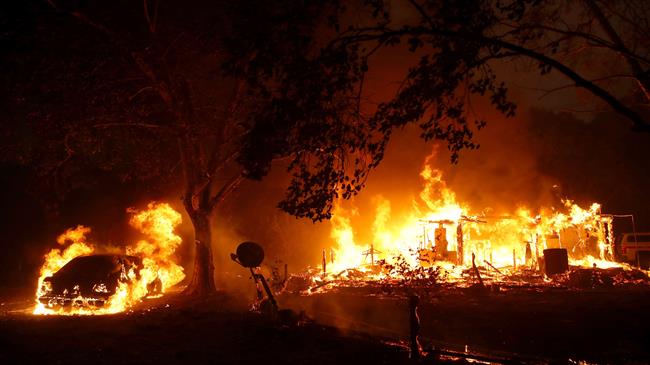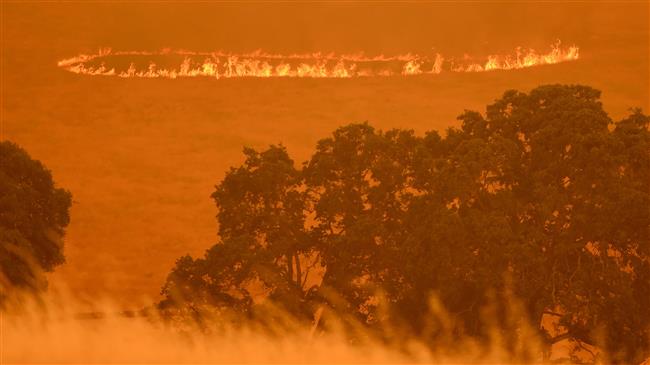Wildfires in California trigger state of emergency in Sonoma, Los Angeles counties
A local state of emergency has been declared in California, where firefighters on Friday sought to take advantage of a lull in winds to gain ground on a pair of fast-moving wildfires, including one that has forced the evacuation of about 50,000 residents in suburbs north of Los Angeles.
California Governor Gavin Newsom on Friday declared a local emergency to assist in fighting that blaze and another one in the wine-growing region of Sonoma County that has destroyed nearly 50 structures and forced the evacuation of 2,000 people.
In Los Angeles County, crews worked overnight to battle the Tick Fire that started on Thursday and has grown to char 4,300 acres (1,700 hectares), threatening 15,000 homes and businesses, officials said.
The blaze has upended life in the suburban Santa Clarita Valley, about 40 miles (60 km) north of downtown Los Angeles, which has been used as the backdrop for many movies and television productions and is home to the Magic Mountain amusement park.
“This is the largest evacuation that we’ve had in Santa Clarita,” Los Angeles County Supervisor Kathryn Barger told a news conference, putting the number of people ordered to evacuate at 50,000.
“This is being done to make sure that we protect not only life but property but also allow our firefighters and first responders to get up there to fight these fires.”
The fire, which was only 5 percent contained, has destroyed six structures, Los Angeles County Fire Chief Daryl Osby said, adding that figure would rise.
Already on Friday morning, images from a television news helicopter showed flames licking a house in the area as firefighters tried to stop the blaze spreading to other homes in that subdivision and up dry, brush-covered canyons.
Smoke from the two fires was disrupting life in two of California’s biggest cities.
A smoky haze drifting toward the Bay Area of San Francisco prompted warnings to residents to stay indoors, close windows and use masks. Los Angeles officials closed dozens of schools in the San Fernando Valley, just south of the Tick blaze, because of fears over hazardous breathing conditions.

Hot fall winds
California’s wildfires often erupt in the fall, whipped by hot, dry winds that blow westward after a dry summer. In November 2018, at least 85 people died in the Camp Fire in Northern California, the deadliest wildfire in state history.
Overnight, winds around the Tick Fire reached speeds of 60 miles per hour (100 kph). They weakened to 20 mph (30 kph) on Friday but scorching temperatures of above 90 degrees Fahrenheit (32 degrees Celsius) were complicating the firefighting effort, Osby said.
By Friday evening or this weekend, the winds could shift and increase in speed, potentially drawing the fire into a wooded area where it would burn through plentiful fuel and gain strength, Osby said.
In northern and central California, where firefighters were battling a smattering of blazes, electric utility crews had restored power to most of the nearly 200,000 homes and businesses that had intentionally been left in the dark because of risk of high winds downing electrical lines.
In Sonoma County, about 80 miles (130 km) north of San Francisco, where the local vintners include “The Godfather” director Francis Ford Coppola, the Kincade Fire has destroyed nearly 22,000 acres (8,900 hectares), officials said.
Crews have carved containment lines around just 5 percent of the fire’s perimeter since it erupted on Wednesday night, fueled by gale-force winds. But light breezes early on Friday helped firefighters make headway.
The blaze has triggered the evacuation of about 2,000 people from the communities of Geyserville and Healdsburg, said Sonoma County Sheriff’s Office spokesman Juan Valencia.

Geyserville and Healdsburg are hubs of upscale restaurants, wine-tasting rooms, inns and shops surrounded by hills dotted with vineyards about 75 miles (120 km) north of San Francisco.
The cause of the Kincade Fire has not been determined, but local officials said it appears to have erupted near the base of a damaged high-voltage transmission tower owned by the bankrupt PG&E Corp (PCG.N).
The utility said in an “electric safety incident” report to the California Public Utilities Commission that one of its power lines malfunctioned at about the time and in the location of the fire’s origin on Wednesday night.
Neither PG&E nor the commission could immediately determine whether the damaged tower or its malfunctioning transmission line ignited the blaze.
Shares of California power utilities tumbled on Friday, with PG&E losing a quarter of its value.
The California Department of Forestry and Fire Protection (Cal Fire) said it was investigating.
No injuries have been reported from the Kincade Fire.
(Source: Reuters)
New footage refutes Israel’s pretext for Palestinian teen’s killing
400 Harvard affiliates slam university for removing pro-Palestine professor
Official: Iran now among world's leaders in infertility treatment
VIDEO | Fighting British state
VIDEO | Press TV's news headlines
Iran, Russia stress strategic partnership as Pezeshkian, Putin meet
Iran stresses need for trust, solidarity among world’s nations
Israel admits it inflicted less damage to Iran than initially thought












 This makes it easy to access the Press TV website
This makes it easy to access the Press TV website